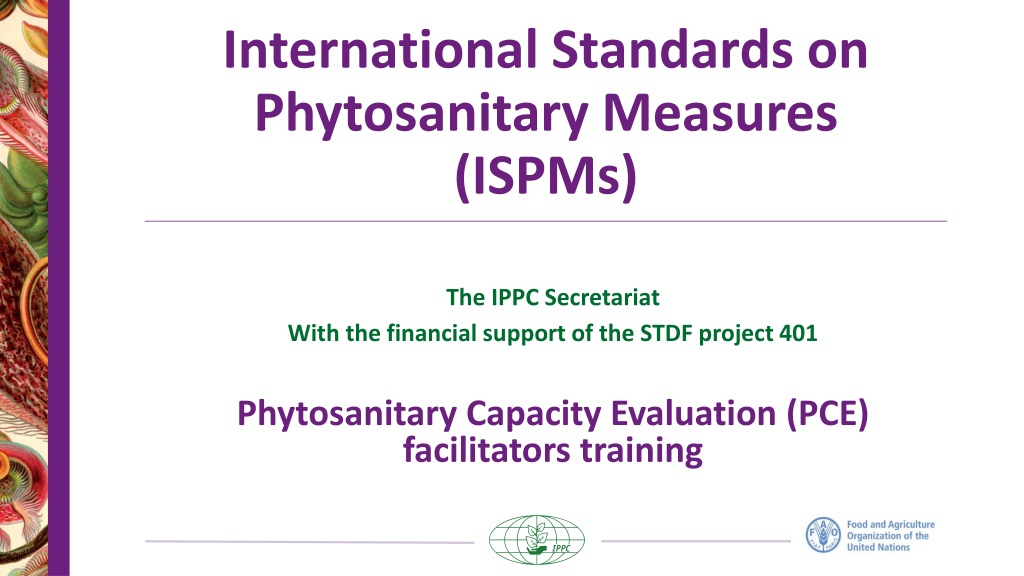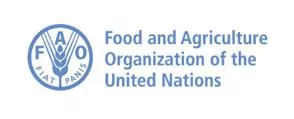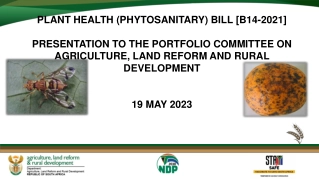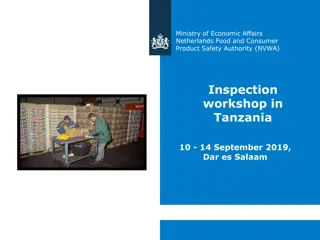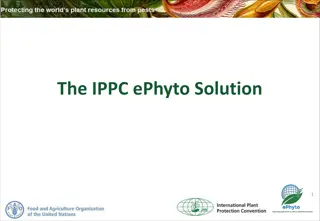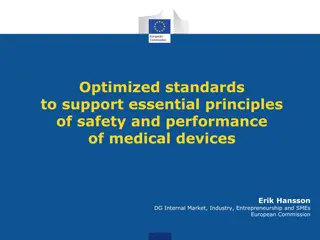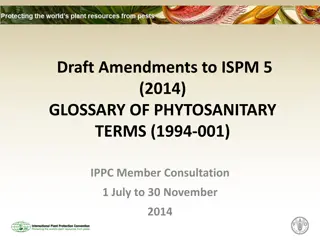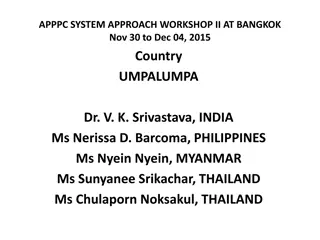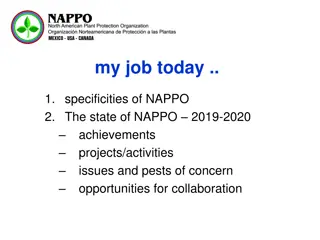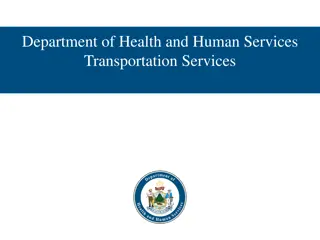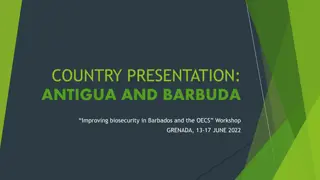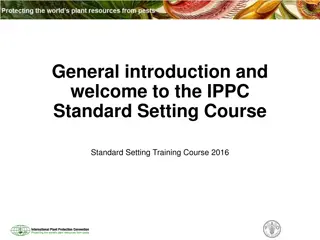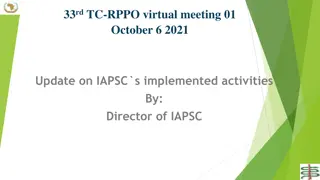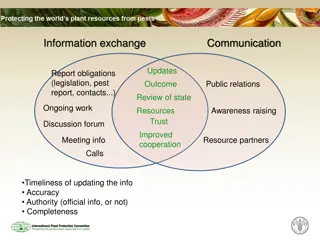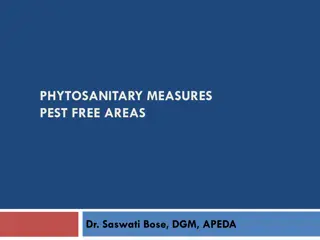International Standards on Phytosanitary Measures (ISPMs) Overview
The International Standards on Phytosanitary Measures (ISPMs) play a crucial role in safeguarding global plant resources from pests. Spearheaded by the IPPC Secretariat and supported by the STDF project 401, these standards aim to enhance phytosanitary capacity worldwide. The ISPM framework covers key aspects such as IPPC's mission and vision, core phytosanitary systems, types of ISPMs, glossary of phytosanitary terms, and basic IPPC principles. Through import regulation, export certification, surveillance, pest risk analysis, and more, ISPMs promote cooperation, transparency, and harmonization in plant protection efforts.
Download Presentation

Please find below an Image/Link to download the presentation.
The content on the website is provided AS IS for your information and personal use only. It may not be sold, licensed, or shared on other websites without obtaining consent from the author. Download presentation by click this link. If you encounter any issues during the download, it is possible that the publisher has removed the file from their server.
E N D
Presentation Transcript
International Standards on Phytosanitary Measures (ISPMs) The IPPC Secretariat With the financial support of the STDF project 401 Phytosanitary Capacity Evaluation (PCE) facilitators training
Outline IPPC and phytosanitary systems ISPMs framework for phytosanitary systems Group exercise
IPPC mission and vision Vision: Protecting global plant resources from pests. The mission: To secure cooperation among nations in protecting global plant resources from the spread and introduction of pests of plants, in order to preserve food security, biodiversity and to facilitate trade.
Phytosanitary systems The core phytosanitary systems: Import regulation Export certification Surveillance Pest risk analysis Pest eradication Pest Free Areas
ISPMs the framework for phytosanitary systems and operations Types of ISPMs: 37 ISPMs plus 12 diagnostic protocols and 21 phytosanitary treatments Conceptual 1, 2, 3, 4, 6, 7, 8, 9, 10, 11, 12, 13, 14, 16,17,18, 19, 20, 21, 22, 23, 24, 25, 26, 29, 30, 31, 32, 34, 35, 36 Reference 5 Umbrella standards 27 and 28 Specific 15 and 33
ISPM 5 - Glossary of phytosanitary terms Scope: This reference standard is a listing of terms and definitions with specific meaning for phytosanitary systems worldwide. It has been developed to provide a harmonized internationally agreed vocabulary associated with International Plant Protection International Standards for Phytosanitary Measures (ISPMs). the implementation Convention of the and (IPPC)
Basic IPPC principles for phytosanitary systems ISPM1 - basic IPPC principles: Sovereignty Necessity Managed risk Minimal impact Transparency Harmonization
Basic IPPC principles for phytosanitary systems ISPM1 - basic IPPC principles: Non-discrimination Technical justification Cooperation Equivalence of phytosanitary measures Modification
ISPM 20 - Guidelines for a phytosanitary import regulatory system Scope: This standard describes the structure and operation of a phytosanitary import regulatory system and the rights, obligations and responsibilities which should be considered in establishing, operating and revising the system.
Phytosanitary import regulatory system involved ISPMs Designation of pest free areas and areas of low pest prevalence Phytosanitary measures in exporting countries ISPM 7, 14, 23, 31 Special imports ISPM 3 ISPM 4,8,10, 22, 26,29 Non-compliance and emergency actions ISPM 13 Pest reporting Recognition of equivalency ISPM 24 ISPM 17
Phytosanitary import regulatory system - justification of phytosanitary measures Lists of regulated pests ISPM 19, 16 Pest Pest status ISPM8 Phyto. measures surveillance ISPM6 PRA ISPM 2, 11, 21
ISPM7 - Phytosanitary certification system Scope: This standard contains requirements and describes components of a phytosanitary certification system to be established by national plant protection organizations (NPPOs). Requirements and guidelines for the preparation and issuance of phytosanitary certificates (phytosanitary certificates for export and phytosanitary certificates for re-export) are described in ISPM 12 (Phytosanitary certificates).
Components of Phytosanitary certification system Import requirements ISPM20 Pest free areas ISPM 4, 8, 10, 26, 29 Inspection ISPM 23, Wood Packaging Material ISPM 15 Sampling ISPM31 Testing ISPM27 Treatments ISPM 18, 28 Issuance of Phytosanitary certificates - ISPM12 Non compliance ISPM13
ISPM 6 - Guidelines for surveillance Scope: This standard describes the components of survey and monitoring systems for the purpose of pest detection and the supply of information for use in pest risk analyses, the establishment of pest free areas and, where appropriate, the preparation of pest lists.
Pest surveillance and lists of regulated pests Surveillance ISPM6 National pest list Pest status ISPM8 Pest risk analysis ISPM 2,11,21 Lists of regulated pests ISPM 19
ISPM 9 - Guidelines for pest eradication programmes Scope: This standard describes the components of a pest eradication programme which can lead to the establishment or re- establishment of pest absence in an area.
Pest eradication programmes steps and ISPMs involved Pest surveillance ISPM6 Diagnostics ISPM27 Eradication/ containment ISPM 9 Phytosanitary treatments ISPM 28 Declaration of eradication ISPM 8
Pest risk analysis ISPM 2, 11 and 21 ISPM2 -Framework for pest risk analysis- Scope: This standard provides a framework that describes the pest risk analysis (PRA) process within the scope of the IPPC. It introduces the three stages of pest risk analysis initiation, pest risk assessment and pest risk management. The standard focuses on the initiation stage. Generic issues of information gathering, documentation, risk communication, uncertainty and consistency are addressed. ISPM11- Pest risk analysis for quarantine pests - Scope: The standard provides details for the conduct of pest risk analysis (PRA) to determine if pests are quarantine pests. It describes the integrated processes to be used for risk assessment as well as the selection of risk management options. ISPM21-Pest risk analysis for regulated non quarantine pests - Scope: This standard provides guidelines for conducting pest risk analysis for regulated non- quarantine pests. It describes the integrated processes to be used for risk assessment and the selection of risk management options to achieve a pest tolerance level.
PRA - justification of phytosanitary measures Pest listing Import requirements Transit ISPM 19, 16 ISPM 25 ISPM 20 Import and release of biological control agents ISPM 3 Equivalence PRA ISPM 24 ISPM 2, 11, 21 System approach ISPM 14 Inspection ISPM 23 Pest free areas ISPM 4,8,10, 22,29
Pest Free Areas ISPMs 4, 10 and 22: Describe the requirements for the establishment and use of pest free areas (PFAs), pest free places of production and pest free production sites (PFPP and PFPS), areas of low pest prevalence (ALPP) as a risk management option for phytosanitary certification of plants and plant products and other regulated articles exported from the PFAs, PFPPs, PFPSs and ALPPs or to support the scientific justification for phytosanitary measures taken by an importing country.
Pest Free Areas ISPMs 29 - Recognition of pest free areas and areas of low pest prevalence This standard provides guidance and describes a procedure for the bilateral recognition of pest free areas and areas of low pest prevalence. This standard does not include specified timelines for the recognition procedure. This standard also provides some considerations regarding pest free places of production and pest free production sites.
Pest Free Areas Group Exercise Breakout into 2 groups. Working in groups: 1. Consider ISPM 4 to identify main components for the establishment, maintenance and recognition of PFAs (use post its) and determine relevant ISPMs. 2. In plenary, present your findings as a group.
